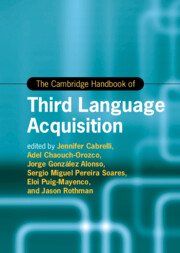Book contents
- The Cambridge Handbook of Third Language Acquisition
- Cambridge Handbooks in Language and Linguistics
- The Cambridge Handbook of Third Language Acquisition
- Copyright page
- Contents
- Figures
- Tables
- Contributors
- Introduction Multilingualism
- Part I Theoretical Approaches to L3/Ln
- Part II L3/Ln across Linguistic Domains
- Part III Becoming and Staying Multilingual at Different Ages
- Part IV L3/Ln in Action
- Part V L3/Ln and Cognition
- Part VI Research Methods in L3/Ln
- 25 Innovations and Challenges in Acquisition and Processing Methodologies for L3/Ln
- 26 Corpus Research
- 27 Case Study Research in Multilingual Contexts
- 28 Using Artificial Languages to Study Third Language Learning and Processing
- 29 Statistical Modeling in L3/Ln Acquisition
- Index
- References
25 - Innovations and Challenges in Acquisition and Processing Methodologies for L3/Ln
from Part VI - Research Methods in L3/Ln
Published online by Cambridge University Press: 13 July 2023
- The Cambridge Handbook of Third Language Acquisition
- Cambridge Handbooks in Language and Linguistics
- The Cambridge Handbook of Third Language Acquisition
- Copyright page
- Contents
- Figures
- Tables
- Contributors
- Introduction Multilingualism
- Part I Theoretical Approaches to L3/Ln
- Part II L3/Ln across Linguistic Domains
- Part III Becoming and Staying Multilingual at Different Ages
- Part IV L3/Ln in Action
- Part V L3/Ln and Cognition
- Part VI Research Methods in L3/Ln
- 25 Innovations and Challenges in Acquisition and Processing Methodologies for L3/Ln
- 26 Corpus Research
- 27 Case Study Research in Multilingual Contexts
- 28 Using Artificial Languages to Study Third Language Learning and Processing
- 29 Statistical Modeling in L3/Ln Acquisition
- Index
- References
Summary
The advent of psycholinguistic and neurolinguistic methodologies has provided new insights into theories of language acquisition. Sequential multilingualism is no exception, and some of the most recent work on the subject has incorporated a particular focus on language processing. This chapter surveys some of the work on the processing of lexical and morphosyntactic aspects of third or further languages, with different offline and online methodologies. We also discuss how, while increasingly sophisticated techniques and experimental designs have improved our understanding of third language acquisition and processing, simpler but clever designs can answer pressing questions in our theoretical debate. We provide examples of both sophistication and clever simplicity in experimental design, and argue that the field would benefit from incorporating a combination of both concepts into future work.
- Type
- Chapter
- Information
- The Cambridge Handbook of Third Language Acquisition , pp. 661 - 682Publisher: Cambridge University PressPrint publication year: 2023

